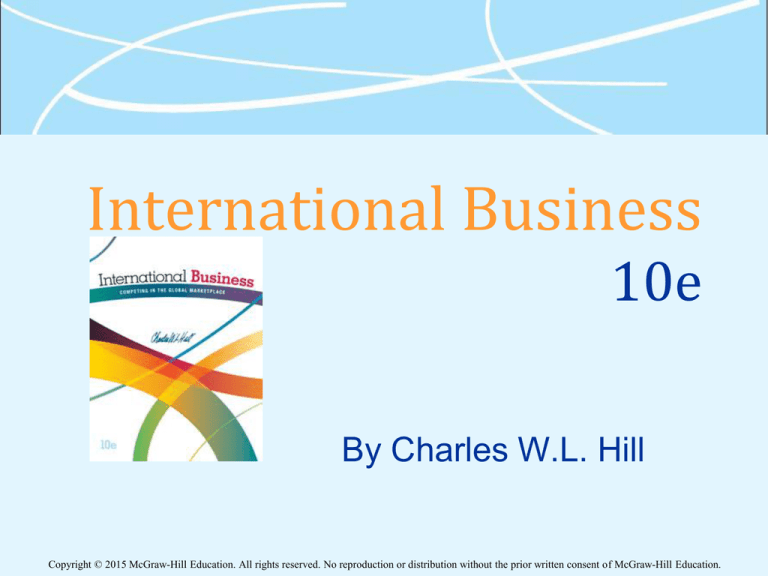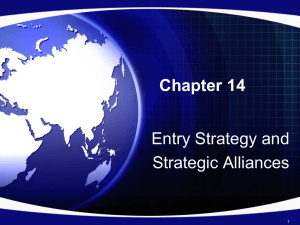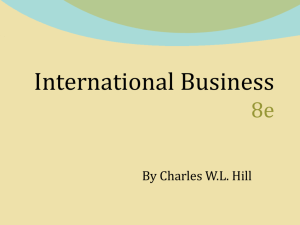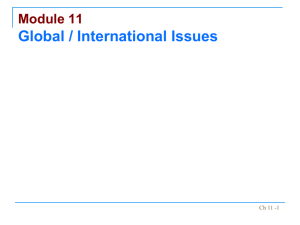
International Business
10e
By Charles W.L. Hill
Copyright © 2015 McGraw-Hill Education. All rights reserved. No reproduction or distribution without the prior written consent of McGraw-Hill Education.
Chapter 15
Entry Strategy and
Strategic Alliances
What Are the Basic Decisions Firms
Make When Expanding Globally?
1.
2.
3.
Firms expanding internationally must decide
Which markets to enter
When to enter them and on what scale
Which entry mode to use
exporting
licensing or franchising to a company in the host
nation
establishing a joint venture with a local company
establishing a new wholly owned subsidiary
acquiring an established enterprise
15-3
What Influences
the Choice of Entry Mode?
Several factors affect the choice of entry mode
including
transport costs
trade barriers
political risks
economic risks
costs
firm strategy
The optimal mode varies by situation – what
makes sense for one company might not make
sense for another
15-4
Which Foreign Markets
Should Firms Enter?
The choice of foreign markets will depend
on their long-run profit potential
Favorable markets
are politically stable
have free market systems
have relatively low inflation rates
have low private sector debt
15-5
Which Foreign Markets
Should Firms Enter?
Less desirable markets
are politically unstable
have mixed or command economies
have excessive levels of borrowing
Markets are also more attractive when the
product in question is not widely available
and satisfies an unmet need
15-6
When Should a Firm
Enter a Foreign Market?
Once attractive markets are identified,
the firm must consider the timing of entry
1. Entry is early when the firm enters a
foreign market before other foreign firms
2. Entry is late when the firm enters the
market after firms have already
established themselves in the market
15-7
Why Enter a
Foreign Market Early?
First-mover advantages include
the ability to preempt rivals by establishing a
strong brand name
the ability to build up sales volume and ride
down the experience curve ahead of rivals
and gain a cost advantage over later
entrants
the ability to create switching costs that tie
customers into products or services making
it difficult for later entrants to win business
15-8
Why Enter a
Foreign Market Late?
First-mover disadvantages include
pioneering costs - arise when the foreign
business system is so different from that in
the home market that the firm must devote
considerable time, effort and expense to
learning the rules of the game
the costs of business failure if the firm,
due to its ignorance of the foreign
environment, makes some major mistakes
the costs of promoting and establishing a
product offering, including the cost of
educating customers
15-9
On What Scale Should a Firm
Enter Foreign Markets?
After choosing which market to enter and the
timing of entry, firms need to decide on the
scale of market entry
firms that enter a market on a significant scale make
a strategic commitment to the market
the decision has a long term impact and is difficult
to reverse
small-scale entry has the advantage of allowing a
firm to learn about a foreign market while
simultaneously limiting the firm’s exposure to that
market
15-10
Is There a “Right” Way to
Enter Foreign Markets?
No, there are no “right” decisions when
deciding which markets to enter, and the
timing and scale of entry - just decisions
that are associated with different levels of
risk and reward
15-11
How Can Firms
Enter Foreign Markets?
These are six different ways to enter a foreign
market
1. Exporting – a common first step for many
manufacturing firms
later, firms may switch to another mode
2. Turnkey projects - the contractor handles every
detail of the project for a foreign client, including
the training of operating personnel
at completion of the contract, the foreign client is
handed the "key" to a plant that is ready for full
operation
15-12
How Can Firms
Enter Foreign Markets?
3. Licensing - a licensor grants the rights to
intangible property to the licensee for a
specified time period, and in return, receives a
royalty fee from the licensee
patents, inventions, formulas, processes, designs,
copyrights, trademarks
4. Franchising - a specialized form of licensing in
which the franchisor not only sells intangible
property to the franchisee, but also insists that
the franchisee agree to abide by strict rules as
to how it does business
used primarily by service firms
15-13
How Can Firms
Enter Foreign Markets?
5. Joint ventures with a host country firm - a
firm that is jointly owned by two or more
otherwise independent firms
most joint ventures are 50–50 partnerships
6. Wholly owned subsidiary - the firm owns
100 percent of the stock
set up a new operation
acquire an established firm
15-14
Why Choose Exporting?
Exporting is attractive because
it avoids the costs of establishing local manufacturing
operations
it helps the firm achieve experience curve and
location economies
Exporting is unattractive because
there may be lower-cost manufacturing locations
high transport costs and tariffs can make it
uneconomical
agents in a foreign country may not act in exporter’s
best interest
15-15
Why Choose a
Turnkey Arrangement?
Turnkey projects are attractive because
they are a way of earning economic returns from the
know-how required to assemble and run a
technologically complex process
they can be less risky than conventional FDI
Turnkey projects are unattractive because
the firm has no long-term interest in the foreign
country
the firm may create a competitor
if the firm's process technology is a source of
competitive advantage, then selling this technology
through a turnkey project is also selling competitive
advantage to potential and/or actual competitors
15-16
Why Choose Licensing?
Licensing is attractive because
the firm avoids development costs and risks
associated with opening a foreign market
the firm avoids barriers to investment
the firm can capitalize on market opportunities
without developing those applications itself
Licensing is unattractive because
the firm doesn’t have the tight control required for
realizing experience curve and location economies
the firm’s ability to coordinate strategic moves across
countries is limited
proprietary (or intangible) assets could be lost
to reduce this risk, use cross-licensing agreements
15-17
Why Choose Franchising?
Franchising is attractive because
it avoids the costs and risks of opening up a foreign
market
firms can quickly build a global presence
Franchising is unattractive because
it inhibits the firm's ability to take profits out of one
country to support competitive attacks in another
the geographic distance of the firm from its
franchisees can make it difficult to detect poor quality
15-18
Why Choose Joint Ventures?
Joint ventures are attractive because
firms benefit from a local partner's knowledge
of the local market, culture, language,
political systems, and business systems
the costs and risks of opening a foreign
market are shared
they satisfy political considerations for market
entry
15-19
Why Choose Joint Ventures?
Joint ventures are unattractive because
the firm risks giving control of its technology
to its partner
the firm may not have the tight control to
realize experience curve or location
economies
shared ownership can lead to conflicts and
battles for control if goals and objectives
differ or change over time
15-20
Why Choose a
Wholly Owned Subsidiary?
Wholly owned subsidiaries are attractive
because
they reduce the risk of losing control over core
competencies
they give a firm the tight control in different countries
necessary for global strategic coordination
they may be required in order to realize location and
experience curve economies
Wholly owned subsidiaries are unattractive
because
the firm bears the full cost and risk of setting up
overseas operations
15-21
Which Entry Mode Is Best?
Advantages and Disadvantages of Entry Modes
15-22
How Do Core Competencies
Influence Entry Mode?
The optimal entry mode depends on the nature
of a firm’s core competencies
When competitive advantage is based on
proprietary technological know-how
avoid licensing and joint ventures unless the
technological advantage is only transitory, or can be
established as the dominant design
When competitive advantage is based on
management know-how
the risk of losing control over the management skills
is not high, and the benefits from getting greater use
of brand names is significant
15-23
How Do Pressures for Cost
Reductions Influence Entry Mode?
When pressure for cost reductions is high,
firms are more likely to pursue some
combination of exporting and wholly
owned subsidiaries
allows the firm to achieve location and scale
economies and retain some control over
product manufacturing and distribution
firms pursuing global standardization or
transnational strategies prefer wholly owned
subsidiaries
15-24
Which Is Better –
Greenfield or Acquisition?
The choice depends on the situation
confronting the firm
1. A greenfield strategy - build a subsidiary
from the ground up
a greenfield venture may be better when the
firm needs to transfer organizationally
embedded competencies, skills, routines,
and culture
15-25
Which Is Better –
Greenfield or Acquisition?
2. An acquisition strategy – acquire an
existing company
acquisition may be better when there are
well-established competitors or global
competitors interested in expanding
The volume of cross-border acquisitions
has been rising for the last two decades
15-26
Why Choose Acquisition?
Acquisitions are attractive because
they are quick to execute
they enable firms to preempt their competitors
they may be less risky than greenfield ventures
Acquisitions can fail when
the acquiring firm overpays for the acquired firm
the cultures of the acquiring and acquired firm clash
anticipated synergies are slow and difficult to achieve
there is inadequate pre-acquisition screening
To avoid these problems, firms should
carefully screen the firm to be acquired
move rapidly to implement an integration plan
15-27
Why Choose Greenfield?
The main advantage of a greenfield
venture is that it gives the firm a greater
ability to build the kind of subsidiary
company that it wants
But, greenfield ventures are slower to
establish
Greenfield ventures are also risky
15-28
What Are Strategic Alliances?
Strategic alliances refer to cooperative
agreements between potential or actual
competitors
range from formal joint ventures to short-term
contractual agreements
the number of strategic alliances has
exploded in recent decades
15-29
Why Choose
Strategic Alliances?
Strategic alliances are attractive because they
facilitate entry into a foreign market
allow firms to share the fixed costs and risks of
developing new products or processes
bring together complementary skills and assets that
neither partner could easily develop on its own
help a firm establish technological standards for the
industry that will benefit the firm
But, the firm needs to be careful not to give
away more than it receives
15-30
What Makes
Strategic Alliances Successful?
The success of an alliance is a function of
1. Partner selection
A good partner
helps the firm achieve its strategic goals and
has the capabilities the firm lacks and that it
values
shares the firm’s vision for the purpose of the
alliance
will not exploit the alliance for its own ends
15-31
What Makes
Strategic Alliances Successful?
2. Alliance structure
The alliance should
make it difficult to transfer technology not
meant to be transferred
have contractual safeguards to guard
against the risk of opportunism by a partner
allow for skills and technology swaps with
equitable gains
minimize the risk of opportunism by an
alliance partner
15-32
What Makes
Strategic Alliances Successful?
3. The manner in which the alliance is
managed
Requires
interpersonal relationships between
managers
cultural sensitivity is important
learning from alliance partners
knowledge must then be diffused through
the organization
15-33








